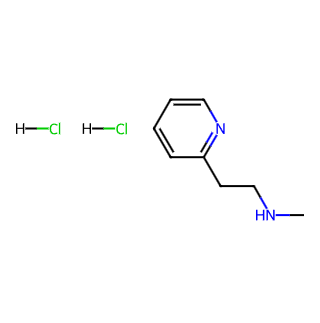- Synthetic anti-infective drugs
- Medications for the digestive system
- Antipyretic and analgesic drugs
- Medications for the blood system
- Medications for the respiratory system
- Anti-allergic drugs
- Medications for the urinary system
- Diagnostic medications
- Immunosuppressive and immunomodulatory drugs
- Vitamins and mineral supplements
- Antioxidants and medications for osteoporosis
- Antiparasitic drugs
- Ophthalmic medications
- Amino acids and their derivatives
- Dermatological medications
- Medications for the circulatory system
- Antitumor drugs
- Medications for the nervous system
- Hormonal and endocrine function-regulating drugs
- Antibiotics
- Others
CAS NO.: 5579-84-0




Basic Information
Chinese Name: 盐酸倍他司汀
English Name: Betahistine Dihydrochloride
Molecular Formula: C8H14Cl2N2 (Note: Variations in molecular weight are possible due to differences in sources, but the given formula results in a molecular weight close to 209.12)
CAS Number: 5579-84-0
EINECS Number: 226-966-5
Physical Properties
Melting Point: 150-154°C (Range may vary slightly across sources)
Density: Approximately 0.967 g/cm³
Chemical Properties
Betahistine Dihydrochloride is freely soluble in water. It should be stored away from moisture, strong oxidizing agents, acids, strong bases, acidic chlorides, acid anhydrides, and other incompatible materials to prevent reactions.
Uses
Betahistine Dihydrochloride is primarily used in the treatment of inner ear vertigo (such as Meniere's disease), cerebral arteriosclerosis, cerebral insufficiency, and hypertension-induced symptoms like dizziness, vomiting, and tinnitus. It acts as a vasodilator, improving blood circulation in the inner ear to alleviate these symptoms.
Safety and Storage
Safety Information: According to GHS (Globally Harmonized System of Classification and Labelling of Chemicals), Betahistine Dihydrochloride may cause irritation to skin, eyes, and respiratory tract. Proper protective measures like wearing protective gloves, protective clothing, and eye/face protection should be taken during handling and storage.
Storage Conditions: Betahistine Dihydrochloride should be stored in a cool, dry, well-ventilated area, away from incompatible materials, sunlight, and extreme heat. It should be kept tightly sealed.
Precautions
Always follow relevant safety procedures and precautions when handling Betahistine Dihydrochloride to ensure the safety of personnel and the environment.

Tai Yau Street, San Po Kong, Kowloon, Hong Kong, China.



